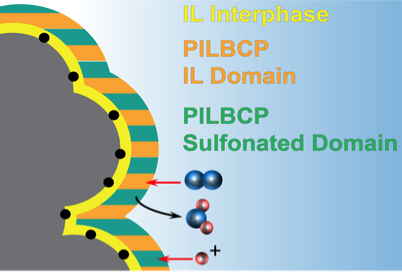
Prof. Snyder
Professor Joshua Snyder, CBE, received a grant for his research titled "PILBCP-IL Composite Ionomers for High Current Density Performance".
Project Description:
It has been demonstrated that a means of further fuel cell cost reduction is through improvement in high-current-density (HCD) performance. For low-PGM electrodes, the interface between Pt and the PFSA-based ionomer electrolyte has been shown to be a major source of HCD performance limitation. The local O2 transport resistance, R_(O_2)^Pt, at the Pt catalyst and PFSA ionomer interface is attributed to the presence of the ionomer thin film in carbon-ionomer agglomerates1. Although the presence of the ionomer is critical for proton transport to the catalysts, the metal/ionomer interface creates an inherent barrier to reactant transport through: (1) specific adsorption of the sulfonic acid groups of the ionomer onto the Pt surface and (2) migration of the polymer chains toward the catalyst surface as a consequence of that specific adsorption. Both result in an impeded O2 transport, exacerbating O2 starvation at HCD.
In this project, we propose that combining ionic liquids with novel ionomers will improve and stabilize the catalyst/ionomer interface to minimize interfacial O2 transport resistances that become limiting at HCD. The goal of this project is to develop a polymerized ionic liquid block co-polymer/ionic liquid (PILBCP/IL) composite ionomer to replace traditional PFSA-based ionomers and address their associated limitations. The expected outcomes include: (1) development of a cathode that meets DOE targets for low and high current density, and (2) improved understanding of how interface engineering affects HCD performance.

Figure 1: Schematic of the interface between catalyst, IL interphase, and PILBCP ionomer. The PILBCP is composed of an IL domain that optimizes the interaction with the IL interphase and a sulfonated domain that provides fast proton transport and water management.